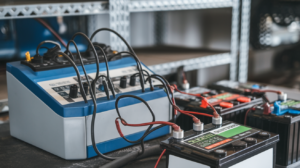Dubai’s heat does not just wear down drivers; it wears down batteries. And fast. What looks like a sudden failure is often slow damage from high temperatures, evaporated electrolytes, and rising internal resistance. No warning. Just silence when the ignition turns on.
Summer breakdowns are common here, especially in vehicles with older batteries or high-demand electrical systems. The heat accelerates wear, and without regular checks, even premium cars can stall without notice. That’s why battery testers are not just tools, they’re preventive shields. They catch voltage drops, detect load issues, and flag batteries that are near failure. For inspection teams, they’re essential for:
- Automotive battery health tracking
- Battery load testing under heat stress
- Seasonal battery diagnostics tailored to UAE conditions
Battery testers help avoid roadside rescues and frustrated clients. They turn reactive service into proactive care, and in Dubai’s climate, that’s not a luxury; it’s a necessity.
What Battery Testers Do?
Battery testers are not just voltage readers; they’re diagnostic tools that tell you what a battery is capable of. And in Dubai’s heat, that matters more than most realize. These devices measure:
- Voltage levels to check if the battery holds a charge.
- Internal resistance increases as batteries degrade.
- State of charge (SOC) and state of health (SOH), two metrics that predict failure before it happens.
Some testers apply a load to simulate real-world conditions. Others use conductance to assess how well a battery can deliver current. Either way, they give service providers a clear picture of battery health without guesswork. In a workshop, battery testers help technicians:
- Spot weak batteries before they cause breakdowns.
- Confirm whether the charging systems are working.
- Decide if a battery needs replacement or just a recharge.
Battery testers are not optional; they’re part of any serious battery health check. And in Dubai, where heat stress is constant, skipping this step is asking for trouble. Skipping a proper check isn’t worth the risk, book a professional car inspection in Dubai to ensure your battery and electrical system are ready for the heat.
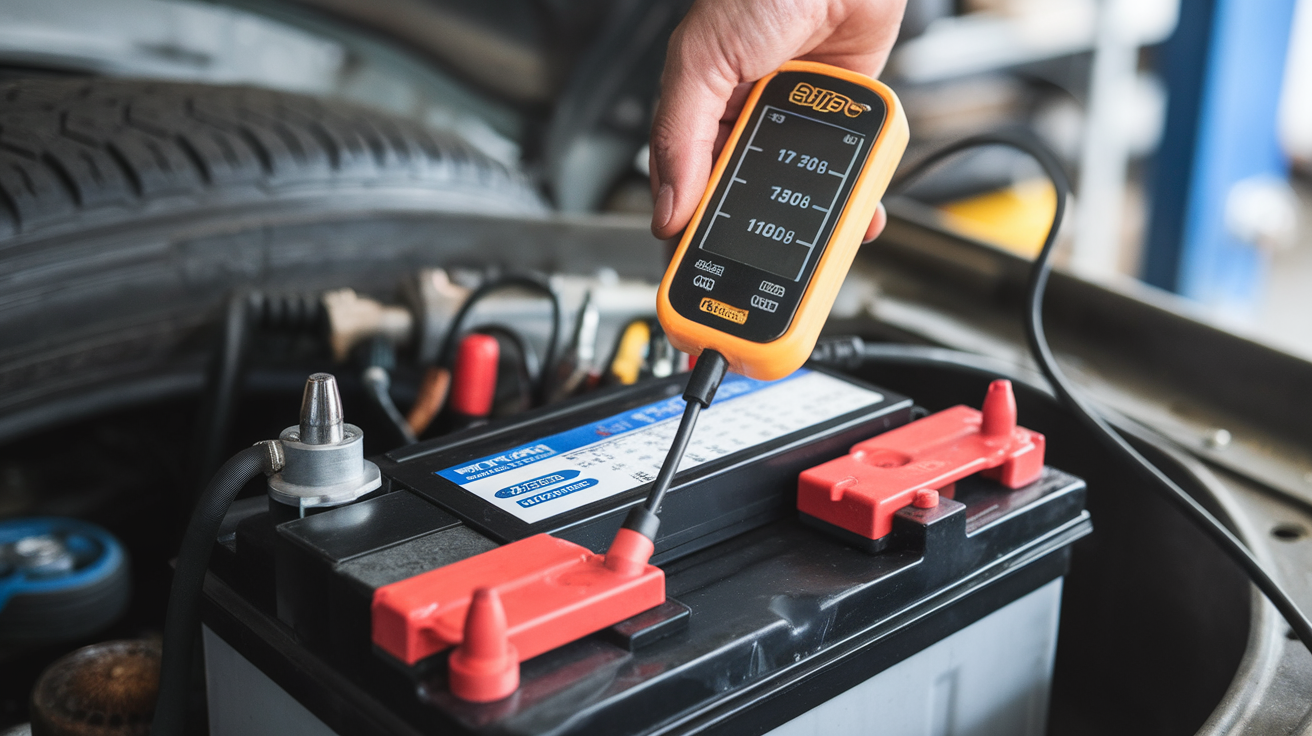
Types of Battery Testers Used in Professional Inspections
Not all battery testers are built the same. Some just blink a voltage reading. Others dig deep into internal resistance, cranking amps, and charge retention. In Dubai’s heat, where battery failure is often silent until it’s too late, choosing the right tool is not optional. Here’s how professionals break it down:
Load Testers
These simulate real-world conditions by applying an electrical load. If the voltage drops too fast, the battery’s toast.
- Ideal for flooded battery diagnostics
- Useful in high-drain vehicle systems
- Not recommended for AGM or gel batteries due to stress
Tip: Load testers are best for batteries under 2 years old with suspected performance issues.
Conductance Testers
These measures how well a battery can conduct current without fully discharging it.
- Fast, non-invasive
- Compatible with AGM battery testers and gel cell battery testers
- Great for quick inspections in high-volume service bays
Multimeter-Based Testers
Basic, but still useful. They check voltage and continuity.
- Limited diagnostic depth
- Good for confirming dead batteries
- Not reliable for battery health check or state of charge
Integrated System Testers
These combine battery analysis with alternator and starter diagnostics.
- Ideal for full automotive battery health inspections
- Often used in luxury service centers
- Supports digital battery analyzer functions
Battery testers in professional inspections are not one-size-fits-all. Each type serves a purpose, and knowing when to use which can mean the difference between a quick fix and a missed failure.
Key Features to Look for in Battery Testers for Summer Use
When the mercury climbs past 40°C, battery testers need more than just basic diagnostics, they need resilience. Heat stress can skew readings, damage casings, and compromise safety. Here’s what professionals prioritize when choosing battery testers for summer use:
- Temperature Tolerance
Look for testers with heat-resistant casing and internal components rated for high ambient temperatures. This ensures consistent performance in Dubai’s extreme climate. - Compatibility with Multiple Battery Types
A versatile tester should handle AGM, gel cell, and flooded batteries with equal precision. Bonus if it supports cranking tests and charging system analysis across these formats. - Safety Features
Built-in reverse polarity protection, thermal protection, and short-circuit safeguards are non-negotiable. These prevent damage during rushed inspections or incorrect hookups. - Speed of Diagnostics
In high-volume service bays, speed matters. Opt for testers with digital battery analyzers and LCDs that deliver instant, readable results, even in direct sunlight
Battery testers designed for summer use aren’t just tougher, they’re smarter, safer, and faster. Choosing the right one means fewer retests, better customer trust, and zero downtime.
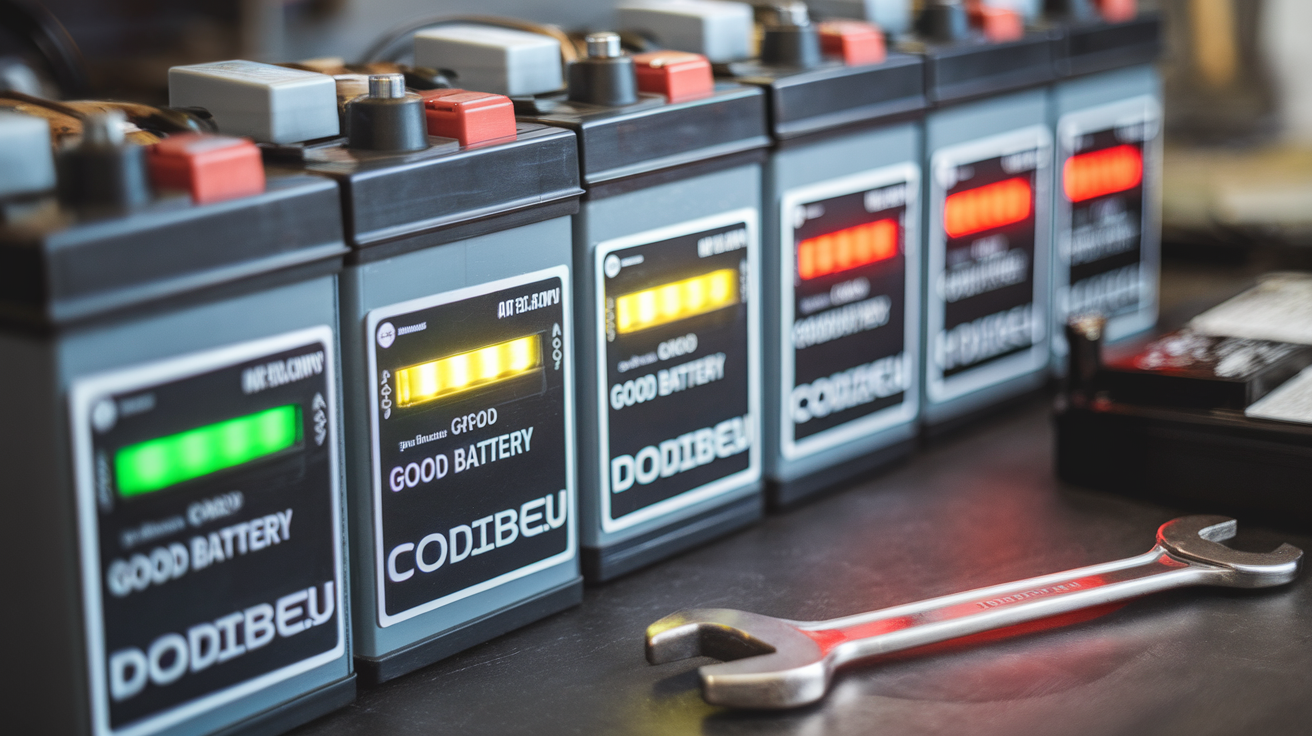
Top Battery Testers That Prevent Summer Breakdowns
Summer heat is brutal on batteries, especially in high-performance vehicles and luxury fleets. Weak cells, poor cranking power, and hidden faults tend to surface when temperatures soar past 40°C. That’s why professional workshops rely on advanced battery testers that go beyond voltage checks. These tools deliver fast, accurate diagnostics across AGM, GEL, and flooded batteries, helping technicians catch failures before they happen. Whether you’re inspecting a supercar in Dubai or a hybrid SUV in Sharjah, the right battery tester can mean the difference between a smooth start and a roadside callout.
| Model | Voltage Range | Battery Types Supported | Diagnostic Depth | Safety Features | Price Range (AED) |
| VDIAGTOOL BT500 | 6V–24V | AGM, GEL, Flooded, EFB | SOH/SOC, CCA, Cranking & Charging Tests | Reverse polarity, spark-proof, over-temp protection | AED 220–295 |
| TOPDON BT100 | 12V | Lead-acid, AGM, GEL | Voltage, CCA, SOH/SOC | Reverse polarity, overload protection | AED 165–240 |
| KONNWEI KW208 | 12V | Flooded, AGM, GEL | Cranking test, alternator test, SOC | Reverse polarity, short-circuit protection | AED 110–185 |
| MOTOPOWER MP0514A | 12V | Lead-acid only | Voltage, charging system analysis | Built-in fuse, reverse polarity | AED 90–145 |
| Hioki 3554-51 | 6V–60V | Industrial, automotive (AGM, GEL, SLA) | Impedance, SOH/SOC, advanced diagnostics | Over-voltage, thermal protection, data logging | AED 1,100–1,850 |
Why These Battery Testers Matter in Summer:
- VDIAGTOOL BT500 is the all-rounder, rugged, fast, and compatible with nearly every battery type.
- TOPDON BT100 delivers reliable SOH/SOC analysis at a mid-range price.
- KONNWEI KW208 is perfect for quick alternator and cranking tests in high-heat conditions.
- MOTOPOWER MP0514A suits basic summer checks without breaking the bank.
- Hioki 3554-51 is the premium choice for deep diagnostics in luxury or industrial setups.
These battery testers are built to withstand heat, deliver fast results, and prevent costly summer breakdowns, especially in high-performance markets like Dubai.
How Battery Testers Integrate into Full Inspection Workflows
In a professional service workflow, battery testers aren’t standalone tools; they’re embedded checkpoints that drive precision, speed, and customer trust. From pre-checks to post-repair validation, they ensure every battery meets performance standards under real-world conditions.
Pre-Service Battery Check
Before any mechanical work begins, technicians run a quick battery load analysis to catch weak cells or low cranking power.
- Helps flag potential electrical issues early
- Feeds into the inspection checklist
- Reduces the risk of mid-service power loss
Mid-Service Diagnostics
During repairs, battery testers validate alternator output and charging system behavior.
- Confirms voltage stability under load
- Supports alternator diagnostics and parasitic drain checks
- Ensures battery health isn’t compromised during service
Post-Repair Validation
After repairs, a final test generates a battery health report for the customer.
- Confirms SOH/SOC metrics
- Verifies system integrity before vehicle release
- Adds credibility to the overall car inspection tools suite
Battery testers are no longer optional; they’re integral to every inspection workflow that values speed, accuracy, and customer satisfaction.
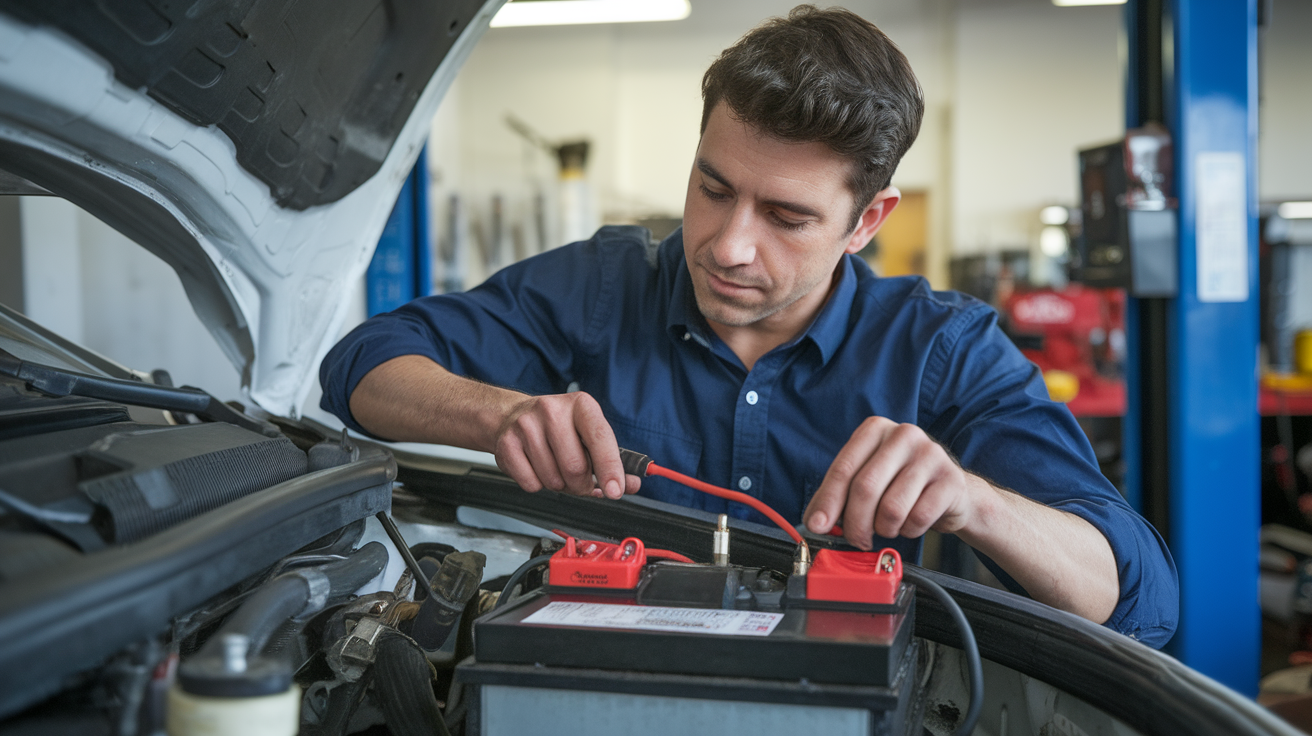
Battery Tester Calibration and Maintenance
Even the most advanced battery testers lose precision over time. In high-stakes environments, like luxury service bays or hybrid diagnostics, accuracy isn’t optional. Calibration and maintenance ensure your tester delivers reliable data, protects your reputation, and prevents costly misdiagnoses.
Why Calibration Matters?
Battery testers rely on internal sensors and algorithms that degrade over time, especially in high-heat environments. Regular calibration restores their diagnostic integrity.
- Measurement drift occurs naturally in electronic components
- Annual calibration ensures accurate SOH/SOC and cranking amp readings
- Prevents false positives and missed battery failures
Maintenance Best Practices
Proper care extends the life of your tester and ensures consistent performance across inspections.
- Calibrate every 12 months, or more frequently in high-use environments
- Replace worn leads and inspect connectors for corrosion
- Store in temperature-controlled areas to protect internal components
- Use reference batteries to verify output between calibrations
Signs Your Tester Needs Attention
If your tester starts behaving erratically, it’s time to recalibrate or service it.
- Inconsistent readings across identical batteries
- LCD flicker or delayed response
- Voltage readings that don’t match multimeter checks
A well-maintained battery tester is the backbone of inspection reliability, especially in summer, when heat can distort readings and accelerate wear.
Understanding Battery Tester Metrics | SOH, SOC, and CCA
Battery testers do more than flash voltage; they decode the battery’s internal story. For technicians and workshop leads, understanding key metrics like SOH, SOC, and CCA is essential for accurate diagnostics, customer trust, and long-term battery health.
SOH – State of Health
SOH reflects how much usable life a battery has left compared to its original capacity.
- Expressed as a percentage of the battery’s rated capacity
- Indicates degradation due to age, heat, and usage cycles
- Critical for deciding whether to replace or retain a battery
SOC – State of Charge
SOC shows how much energy is currently available in the battery, like a fuel gauge.
- Measured as a percentage of full charge
- Helps assess readiness for cranking or loading
- Influenced by temperature, load, and battery chemistry
CCA – Cold Cranking Amps
CCA measures the battery’s ability to start an engine under load, especially in cold or stressed conditions.
- Key for evaluating starter performance
- Tested under simulated load using battery testers
- Low CCA often signals internal resistance or sulfation
Professional battery testers use these metrics to deliver precise, actionable insights, far beyond what a multimeter or visual check can offer. Understanding them turns raw data into confident decisions.
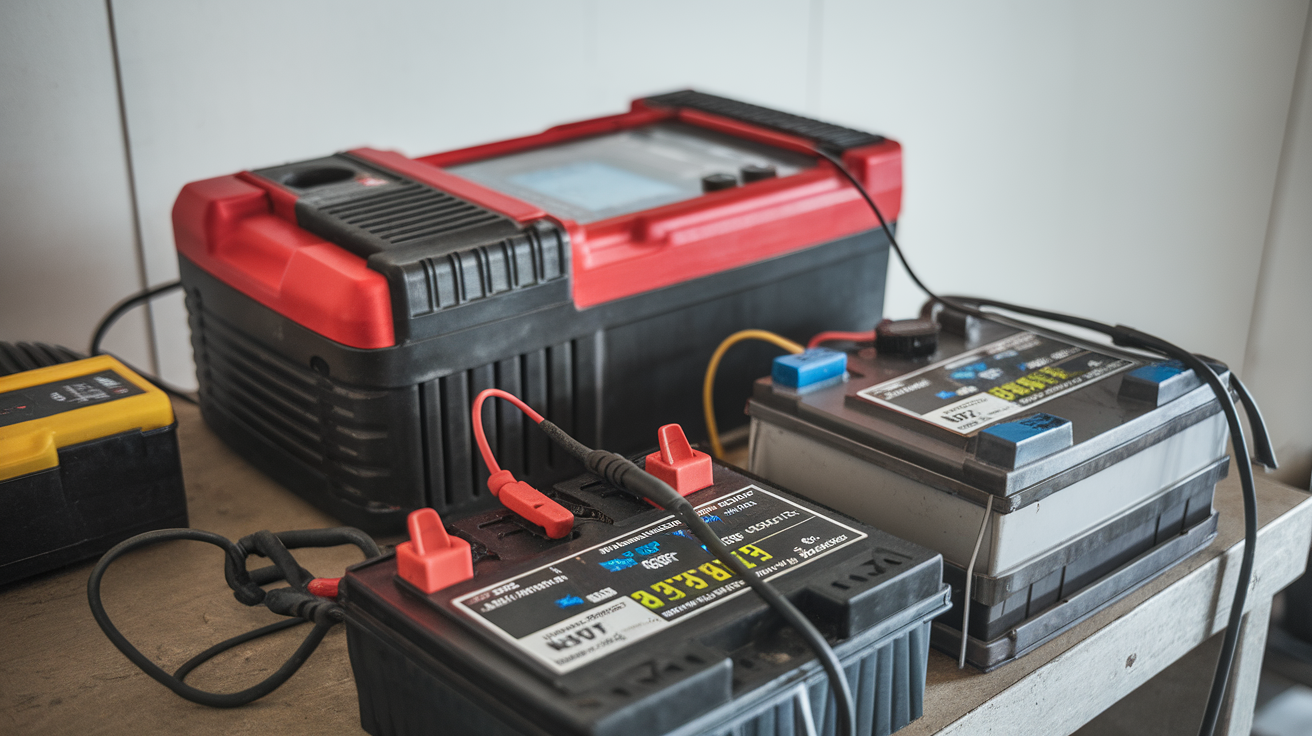
Battery Tester Use in Hybrid and EV Diagnostics
Hybrid and electric vehicles don’t play by the same rules. Their battery systems are complex, high-voltage, and tightly integrated with onboard electronics. Standard battery testers won’t cut it here. You need tools designed for traction packs, module-level analysis, and BMS communication.
Why EV Battery Testing Is Different
EVs and hybrids use lithium-ion or nickel-metal hydride packs with multiple modules. Diagnosing them requires more than a voltage check; it demands real-time data, stress testing, and system-level analysis.
- High-voltage systems (up to 800V)
- Battery Management System (BMS) integration
- Cell balancing and insulation resistance checks
Tools Designed for EV and Hybrid Diagnostics
Advanced testers like BattScan and Aviloo offer guided road tests, module-level SOH reports, and manufacturer-independent scoring.
- BattScan uses voice-guided driving tests to assess battery health
- Aviloo’s FLASH test delivers a full report in minutes, covering SOC, voltage spread, and degradation trends
- NuVant’s EVd-40 supports aftermarket pack testing with smart discharge tech
Hybrid diagnostics demand more advanced tools than conventional checks, as we explained in our guide to AI car inspection technologies that are reshaping Dubai’s auto industry.
Safety and Workflow Considerations
Testing EV batteries isn’t just technical, it’s procedural.
- Use insulated gloves and HV-rated connectors
- Follow OEM shutdown protocols before connecting testers
- Always document results for warranty and service history
Battery testers built for EVs and hybrids are not upgrades; they’re necessities. As Dubai’s market shifts toward electrification, workshops that invest in these tools stay ahead of the curve.
Common Battery Issues Detected by Testers in Summer
High temperatures accelerate battery degradation, especially in luxury and high-performance vehicles. Professional battery testers are essential for catching heat-induced failures before they become roadside emergencies. Common Summer Faults Identified:
- Overheating
Excessive ambient heat can trigger thermal runaway or cause internal components to swell, leading to voltage instability and premature failure. - Low Cranking Amps
Heat thins the electrolyte, reducing the battery’s ability to deliver cold cranking amps, often flagged during SOH/SOC analysis. - Internal Resistance Spikes
Sulfation and electrolyte evaporation increase internal resistance, which testers detect as poor current flow or erratic voltage drops.
Advanced battery testers catch these issues early, helping workshops prevent summer battery failure and maintain system reliability under extreme conditions. High internal resistance and low cranking amps don’t just stop engines from starting, they often lead to roadside failures, similar to issues we highlighted in our blog on cars failing RTA inspections.
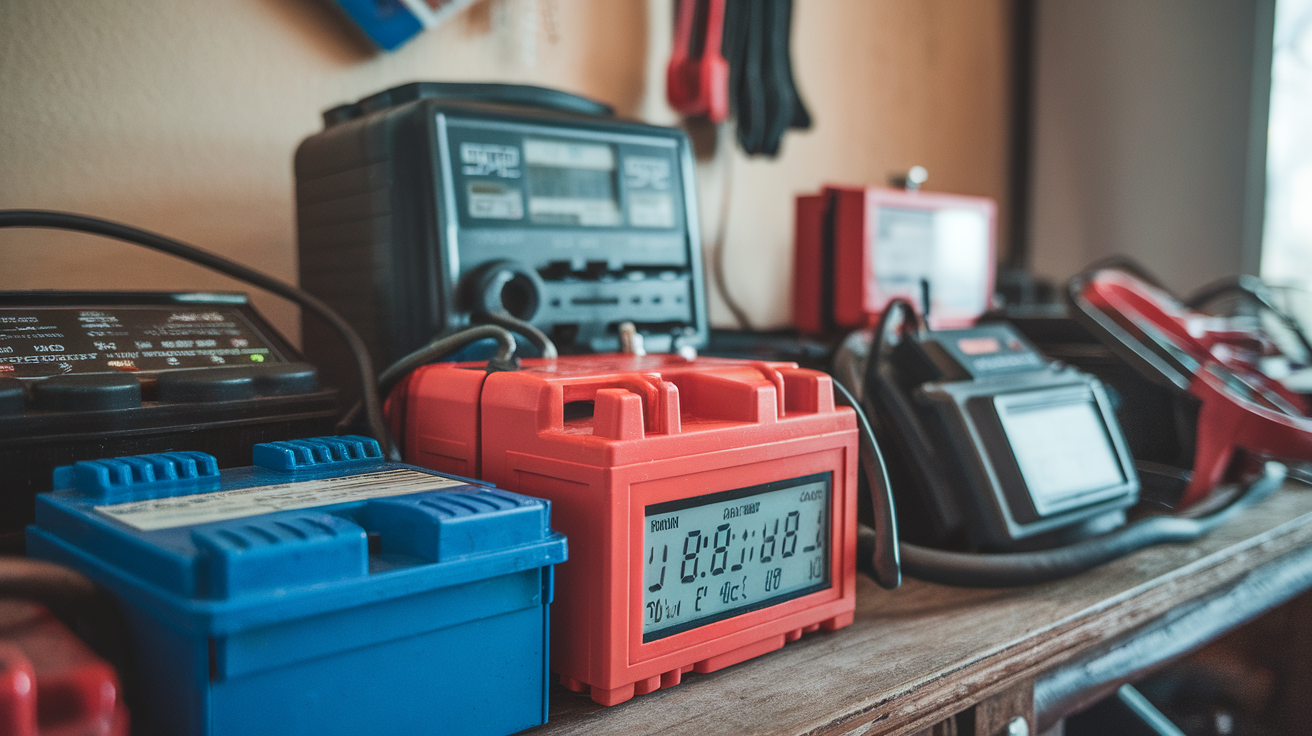
Choosing the Right Battery Tester for Your Workshop
Not all battery testers are built for the rigors of a professional service bay. Whether you’re running diagnostics on luxury vehicles or managing high-volume inspections, the right tool must balance speed, accuracy, and durability.
Budget vs. Premium Models
- Budget testers offer basic voltage and cranking checks—ideal for quick triage.
- Premium models deliver full SOH/SOC analysis, alternator diagnostics, and integrate with scan tools for deeper insights.
- Choose based on your service volume and diagnostic depth needs.
Compatibility with Inspection Software
- Look for workshop-grade testers that sync with digital platforms or scan tools.
- Integration with inspection-grade tools streamlines reporting and improves technician efficiency.
Portability and Durability
- A good battery tester for professionals should be compact, rugged, and heat-resistant.
- Rubberized casing, backlit LCDs, and long cable leads improve usability in tight service bays.
In modern workshops, battery testers aren’t just tools; they’re diagnostic anchors that support fast, reliable, and scalable service workflows.
Battery Testers as Summer Breakdown Prevention Tools
In summer, battery failure isn’t just common, it’s predictable. High temperatures accelerate electrolyte evaporation, increase internal resistance, and trigger heat-induced voltage drops. Professional battery testers help workshops catch these issues before they leave drivers stranded. By integrating battery checks into every summer car service, technicians can:
- Detect early signs of battery degradation
- Validate alternator output and charging system stability
- Provide battery health assurance through SOH/SOC reports
Modern battery testers also support inspection reliability by generating clear, shareable diagnostics, ideal for building customer trust and preventing repeat visits. In Dubai’s climate, they’re not just tools, they’re a frontline defense against seasonal breakdowns.

